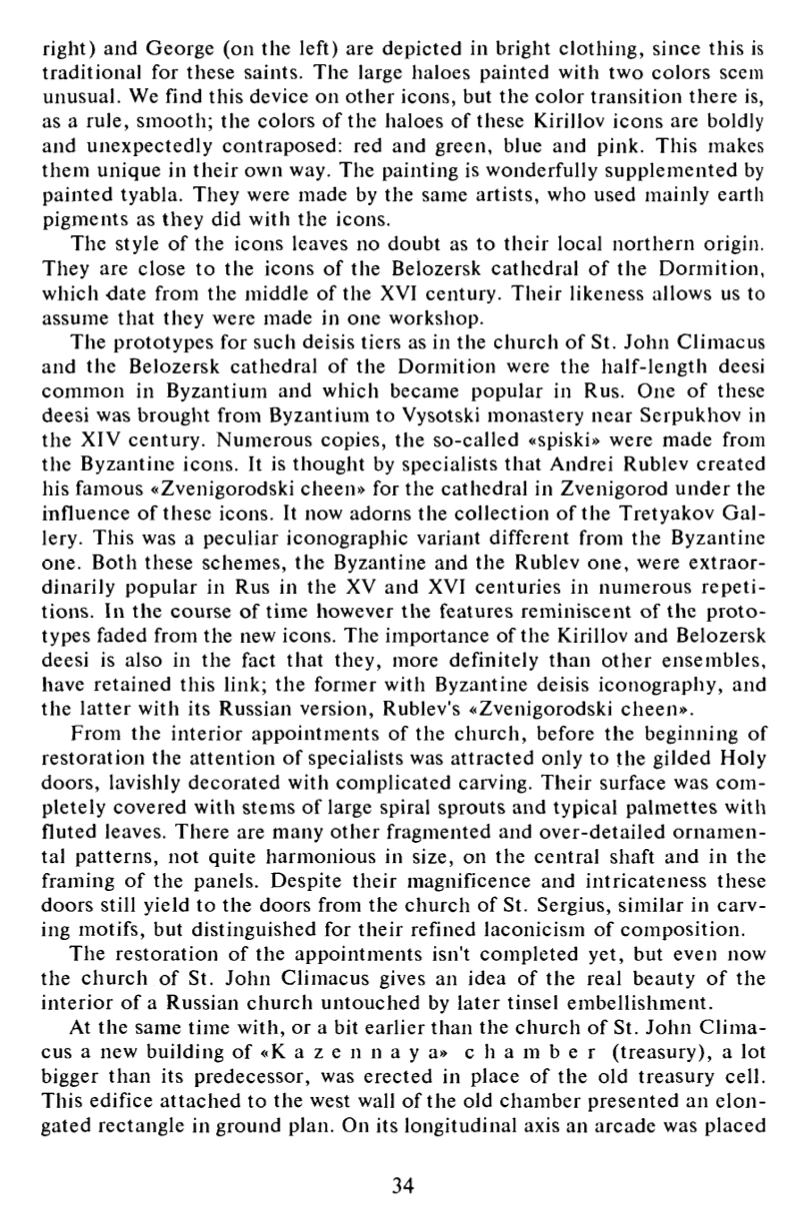

right) and George (on the left) are depicted in bright clothing, since this is
traditional for these saints. The large haloes painted with two colors seem
unusual. We find this device on other icons, but the color transition there is,
as a rule, smooth; the colors of the haloes of these Kirillov icons are boldly
and unexpectedly contraposed: red and green, blue and pink. This makes
them unique in their own way. The painting is wonderfully supp lemen ted by
painted tyabla. They were made by the same artists, who used mainly earth
pigments as they did with the icons.
The style of the icons leaves no doubt as to their local no rthe rn origin.
They are close to the icons of the Belozersk cathedral o f the Dormition,
which date from the middle of the XVI century. Their likeness allows us to
assume that they were made in one workshop.
The prototypes for such deisis tiers as in the church of St. John Climacus
and the Belozersk cathedral of the Dormition were the half-length deesi
common in Byzantium and which became popular in Rus. One o f these
deesi was brought from Byzantium to Vysotski monastery near Serpukhov in
the XIV century. Numerous copies, the so-called «spiski» were made from
the Byzantine icons. It is thought by specialists that Andrei Rublev created
his famous «Zvenigorodski cheen» for the cathedral in Zvenigorod unde r the
influence o f these icons. It now adorns the collection o f the Tretyakov G a l
lery. This was a peculiar iconographic variant different from the Byzantine
one. Both these schemes, the Byzantine and the Rublev one, were ex trao r
dinarily popular in Rus in the XV and XVI centuries in numerous r ep e ti
tions. In the course o f time however the features reminiscent o f the p r o to
types faded from the new icons. The importance of the Kirillov and Belozersk
deesi is also in the fact that they, more definitely than o ther ensembles,
have retained this link; the former with Byzantine deisis iconography, and
the latte r with its Russian version, Rublev's «Zvenigorodski cheen».
From the in terior appointments of the church , before the beginning of
restoration the a tten tion of specialists was attracted only to the gilded Holy
doors, lavishly decorated with complicated carving. Their surface was c om
pletely covered with stems of large spiral sprouts and typical palmettes with
fluted leaves. There are many o ther fragmented and over-detailed o rn am en
tal patterns, not quite harmonious in size, on the central shaft and in the
framing o f the panels. Despite their magnificence and in tricateness these
doors still yield to the doors from the church of St. Sergius, similar in ca rv
ing motifs, but distinguished for their refined laconicism of composition.
The restoration of the appointments isn't completed yet, but even now
the chu rch of St. John Climacus gives an idea of the real beauty o f the
in terior o f a Russian chu rch untouched by later tinsel embellishment.
At the same time with, or a bit earlier than the church o f St. John C lima
cus a new building of «К a z e
11
n а у a» c h a m b e r (treasury), a lot
bigger than its predecessor, was erected in place of the old treasury cell.
This edifice a ttached to the west wall of the old chamber presented an e lon
gated rectangle in ground plan. On its longitudinal axis an arcade was placed
34















